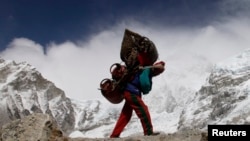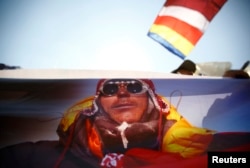NEW DELHI —
Nepal's deadly accident on Mount Everest that killed 16 local guides a week ago has thrown the climbing season into disarray. Mourning for the ethnic Sherpa guides has turned to debate over the huge risks they face in an increasingly commercialized industry.
According to Indian Army Colonel Satish Sharma, who scaled Mount Everest in 2001 and led another expedition in 2013, Sherpa guides moved ahead of the climbers, shaving off huge blocks of ice and carving out paths — something that does not happen on most other peaks.
“It has a steep gradient," he said, describing the Sherpas' work as often dangerous, particularly on a perilous stretch known as the Khumbha Icefall, the fastest moving glacier in the world.
"If you open the route in the morning and you are coming back in the afternoon, sometimes you have to change the route," Sharma said. "If you put the ladder, sometimes the ladder crumbles by evening, before the members start moving up the glacier.
Sharma said the Sherpas are called "the Khumbha Icefall doctors." "They move up this glacier early in the morning," he said. "As early as 2 or 3 a.m., they start opening the route, fixing the ladders.”
It was along the Khumba Icefall that a massive piece of ice fell, burying at least 13 Sherpas in the single deadliest accident on the mountain. Three others are missing and presumed dead.
Those who have scaled Everest say the risks facing Sherpas have risen sharply over the last decade, as the 8,850-meter peak has turned into what Sharma calls a “commercial mountain."
Others say Everest is no longer a mountaineer’s ultimate challenge, but a valuable piece of real estate from which the government and private Western trekking outfits make millions of dollars.
A tough and dangerous job
Sold as a tourist package to hundreds of people, often with little experience scaling such rigorous peaks, a trip up Everest no longer involves opening treacherous routes or ferrying oxygen, ropes and other equipment.
That job has been fully handed over to the Sherpas, whose challenge is to ease the path through danger zones for mostly foreign climbers so they conserve their energy for the final bid on the summit. While all climbers cross the Khumbha Icefall once, Sherpas makes dozens of trips.
The recent accident, in which all those killed were local guides, underscored the constantn risks they face.
Hardy residents of mountain-hugging villages, the Sherpas undertake such intensely dangerous work because it affords them some $3,000 to $6,000 for a three-month climbing season — several times the average earnings in a poor country.
But according to Sharad Pradhan of the Nepal Tourism Board, the once-impoverished Sherpa villages have benefited.
“If you just see the demographic situation, Sherpas are one of the most well off communities in Nepal," he said. "That is because of all this trekking and climbing. There is no other alternative for them other than climbing or helping the expeditions.”
Meager compensation
But the Sherpas' unexpected refusal to guide climbers in the aftermath of the recent tragedy is perceived by many as a sign of resentment over the small fraction of revenue that guides earn from the extremely lucrative — and extremely dangerous — expeditions.
The initial spark of anger among Sherpas was the $400 compensation offered by the government to families of those buried in the avalanche.
Government officials have since offered additional relief and said they would raise the amount of insurance coverage for Sherpas.
Too little, too late
But it may be too late to rescue this year’s climbing season, as many foreign teams are already packing up to leave.
“They are in grief, you know, they have lost friends," said Sobit Kunwar of the Nepal National Mountain Guide Association. "They want attention [of the] government of Nepal to do certain good things, certain welfare for the families [who] lost their man on the mountain.”
The head of the Nepal Mountaineering Association, Ang Tshering Sherpa, who also operates a trekking company, echoes the sentiment, explaining that most Sherpas aren't likely to walk off the mountain but are in shock.
“The climbing community is very tight in family circle and that is why they are very shocked and upset," he said. "Everyday they do 'pujas' for departed souls.”
Catering to wealthy climbers
Some mountaineers feel that the resentment over pay and benefits among Sherpas could be linked to the increasingly luxurious experience that an Everest expedition offers to those who can afford to pay.
Sharma noticed a huge difference in the 12 years between his first and second trips.
"Base camp is becoming a five-star kind of a resort," he said. "There are expeditions who bring their inflatable bathing tubs, also all communication equipment ... Facebook and everything. People are buying it and service providers are giving them. This is adding to the problem also.”
The disarray on Everest means the world’s highest peak may not get too many visitors this season. But most observers are confident that, despite the risks, the Sherpas will again tackle the rigors of high-altitude climbing, resuming the risky livelihood that is the only job they know.
According to Indian Army Colonel Satish Sharma, who scaled Mount Everest in 2001 and led another expedition in 2013, Sherpa guides moved ahead of the climbers, shaving off huge blocks of ice and carving out paths — something that does not happen on most other peaks.
“It has a steep gradient," he said, describing the Sherpas' work as often dangerous, particularly on a perilous stretch known as the Khumbha Icefall, the fastest moving glacier in the world.
"If you open the route in the morning and you are coming back in the afternoon, sometimes you have to change the route," Sharma said. "If you put the ladder, sometimes the ladder crumbles by evening, before the members start moving up the glacier.
Sharma said the Sherpas are called "the Khumbha Icefall doctors." "They move up this glacier early in the morning," he said. "As early as 2 or 3 a.m., they start opening the route, fixing the ladders.”
It was along the Khumba Icefall that a massive piece of ice fell, burying at least 13 Sherpas in the single deadliest accident on the mountain. Three others are missing and presumed dead.
Those who have scaled Everest say the risks facing Sherpas have risen sharply over the last decade, as the 8,850-meter peak has turned into what Sharma calls a “commercial mountain."
Others say Everest is no longer a mountaineer’s ultimate challenge, but a valuable piece of real estate from which the government and private Western trekking outfits make millions of dollars.
A tough and dangerous job
Sold as a tourist package to hundreds of people, often with little experience scaling such rigorous peaks, a trip up Everest no longer involves opening treacherous routes or ferrying oxygen, ropes and other equipment.
That job has been fully handed over to the Sherpas, whose challenge is to ease the path through danger zones for mostly foreign climbers so they conserve their energy for the final bid on the summit. While all climbers cross the Khumbha Icefall once, Sherpas makes dozens of trips.
The recent accident, in which all those killed were local guides, underscored the constantn risks they face.
Hardy residents of mountain-hugging villages, the Sherpas undertake such intensely dangerous work because it affords them some $3,000 to $6,000 for a three-month climbing season — several times the average earnings in a poor country.
But according to Sharad Pradhan of the Nepal Tourism Board, the once-impoverished Sherpa villages have benefited.
“If you just see the demographic situation, Sherpas are one of the most well off communities in Nepal," he said. "That is because of all this trekking and climbing. There is no other alternative for them other than climbing or helping the expeditions.”
Meager compensation
But the Sherpas' unexpected refusal to guide climbers in the aftermath of the recent tragedy is perceived by many as a sign of resentment over the small fraction of revenue that guides earn from the extremely lucrative — and extremely dangerous — expeditions.
The initial spark of anger among Sherpas was the $400 compensation offered by the government to families of those buried in the avalanche.
Government officials have since offered additional relief and said they would raise the amount of insurance coverage for Sherpas.
Too little, too late
But it may be too late to rescue this year’s climbing season, as many foreign teams are already packing up to leave.
“They are in grief, you know, they have lost friends," said Sobit Kunwar of the Nepal National Mountain Guide Association. "They want attention [of the] government of Nepal to do certain good things, certain welfare for the families [who] lost their man on the mountain.”
The head of the Nepal Mountaineering Association, Ang Tshering Sherpa, who also operates a trekking company, echoes the sentiment, explaining that most Sherpas aren't likely to walk off the mountain but are in shock.
“The climbing community is very tight in family circle and that is why they are very shocked and upset," he said. "Everyday they do 'pujas' for departed souls.”
Catering to wealthy climbers
Some mountaineers feel that the resentment over pay and benefits among Sherpas could be linked to the increasingly luxurious experience that an Everest expedition offers to those who can afford to pay.
Sharma noticed a huge difference in the 12 years between his first and second trips.
"Base camp is becoming a five-star kind of a resort," he said. "There are expeditions who bring their inflatable bathing tubs, also all communication equipment ... Facebook and everything. People are buying it and service providers are giving them. This is adding to the problem also.”
The disarray on Everest means the world’s highest peak may not get too many visitors this season. But most observers are confident that, despite the risks, the Sherpas will again tackle the rigors of high-altitude climbing, resuming the risky livelihood that is the only job they know.









